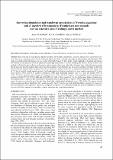Files in this item
Surveying abundance and stand type associations of Formica aquilonia and F. lugubris (Hymenoptera: Formicidae) nest mounds over an extensive area : Trialing a novel method
Item metadata
| dc.contributor.author | Borkin, Kerry | |
| dc.contributor.author | Summers, Ron | |
| dc.contributor.author | Thomas, Len | |
| dc.date.accessioned | 2018-10-17T14:30:12Z | |
| dc.date.available | 2018-10-17T14:30:12Z | |
| dc.date.issued | 2012-01-03 | |
| dc.identifier | 5285592 | |
| dc.identifier | aa10e06c-027d-482c-beef-a795410a9be5 | |
| dc.identifier | 84865189198 | |
| dc.identifier | 84865189198 | |
| dc.identifier.citation | Borkin , K , Summers , R & Thomas , L 2012 , ' Surveying abundance and stand type associations of Formica aquilonia and F. lugubris (Hymenoptera: Formicidae) nest mounds over an extensive area : Trialing a novel method ' , European Journal of Entomology , vol. 109 , no. 1 , pp. 47-53 . https://doi.org/10.14411/eje.2012.007 | en |
| dc.identifier.other | ORCID: /0000-0002-7436-067X/work/54818839 | |
| dc.identifier.uri | https://hdl.handle.net/10023/16260 | |
| dc.description.abstract | Red wood ants are ecologically important members of woodland communities, and some species are of conservation concern. They occur commonly only in certain habitats in Britain, but there is limited knowledge of their numbers and distribution. This study provided baseline information at a key locality (Abernethy Forest, 37 km2) in the central Highlands of Scotland and trialed a new method of surveying red wood ant density and stand type associations: a distance sampling line transect survey of nests. This method is efficient because it allows an observer to quickly survey a large area either side of transect lines, without having to assume that all nests are detected. Instead, data collected on the distance of nests from the line are used to estimate probability of detection and the effective transect width, using the free software "Distance". Surveys took place in August and September 2003 along a total of 71.2 km of parallel, equally-spaced transects. One hundred and forty-four red wood ant nests were located, comprising 89 F. aquilonia (Yarrow, 1955) and 55 F. lugubris (Zetterstedt, 1838) nests. Estimated densities were 1.13 nests per hectare (95% CI 0.74-1.73) for F. aquilonia and 0.83 nests per hectare (95% CI 0.32-2.17) for F. lugubris. These translated to total estimated nest numbers of 4,200 (95% CI 2,700-6,400) and 3,100 (95% CI 1,200-8,100), respectively, for the whole forest. Indices of stand selection indicated that F. aquilonia had some positive association with old-growth and F. lugubris with younger stands (stem exclusion stage). No nests were found in areas that had been clear-felled, and ploughed and planted in the 1970s-1990s. The pattern of stand type association and hence distribution of F. aquilonia and F. lugubris may be due to the differing ability to disperse (F. lugubris is the faster disperser) and compete (F. aquilonia is competitively superior). We recommend using line transect sampling for extensive surveys of ants that construct nest mounds to estimate abundance and stand type association. | |
| dc.format.extent | 7 | |
| dc.format.extent | 149046 | |
| dc.language.iso | eng | |
| dc.relation.ispartof | European Journal of Entomology | en |
| dc.rights | This is an open access article distributed under the terms of the Creative Commons Attribution License (CC BY), which permits use, distribution, and reproduction in any medium, provided the original publication is properly cited. No use, distribution or reproduction is permitted which does not comply with these terms. | en |
| dc.subject | Distance sampling | en |
| dc.subject | Formica | en |
| dc.subject | Formicidae | en |
| dc.subject | Hymenoptera | en |
| dc.subject | Line transect | en |
| dc.subject | Old-growth | en |
| dc.subject | Pinus sylvestris | en |
| dc.subject | Scotland | en |
| dc.subject | QA Mathematics | en |
| dc.subject | QH301 Biology | en |
| dc.subject | Insect Science | en |
| dc.subject.lcc | QA | en |
| dc.subject.lcc | QH301 | en |
| dc.title | Surveying abundance and stand type associations of Formica aquilonia and F. lugubris (Hymenoptera: Formicidae) nest mounds over an extensive area : Trialing a novel method | en |
| dc.type | Journal article | en |
| dc.contributor.institution | University of St Andrews.School of Mathematics and Statistics | en |
| dc.contributor.institution | University of St Andrews.Scottish Oceans Institute | en |
| dc.contributor.institution | University of St Andrews.Centre for Research into Ecological & Environmental Modelling | en |
| dc.contributor.institution | University of St Andrews.Marine Alliance for Science & Technology Scotland | en |
| dc.identifier.doi | 10.14411/eje.2012.007 | |
| dc.description.status | Peer reviewed | en |
| dc.identifier.url | http://www.eje.cz/pdfarticles/1679/eje_109_1_047_Borkin.pdf | en |
This item appears in the following Collection(s)
Items in the St Andrews Research Repository are protected by copyright, with all rights reserved, unless otherwise indicated.

